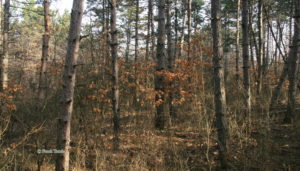General description of project area
Name of the project area: Gyöngyösi Sár-hegy
Surface area (ha): 47.910
EU protection status SPA: –
EU protection status SCI: NATURA 2000 Code HUBN20046
Other protection status according to national or regional legislation: Gyöngyösi Sár-hegy Nature Conservation Area
The main uses of the project site: The main land uses: Nature Conservation 50%, tourism 30%, forestry 20%
The ownership status: Sate property 100%

Scientific description of project area
The Sár-hegy is located on andesite bedrock 260-500 m a.s.l. Over of the andesite bedrock there are piroclasticum, agglomerate and andesite tuff. The true biogeographic significance of the volcanic mountain protruding south of the mass of the Mátra Mountains is that it is open towards the Great Hungarian Plain and thus mountain fringe elements could easily mix with primarily continental steppic elements. The most valuable habitats are Stipa steppe grasslands, which evolved on the area of abandoned vineyards, dwarf almond thickets and Hungarian meadow-grass rock grasslands. The W and N slopes are covered by 91G0*Pannonic woods with Quercus petraea andCarpinus betulus (4,9%), 91H0 *Pannonian woods with Quercus pubescens (33,3%), 91M0 Pannonian-Balkanic turkey oak –sessile oak forests (23,3%), Pinus nigra forest plantation is covering 33% of the original 91H0 *Pannonian woods with Quercus pubescens forest’s area. while along the ridge 40A0*Subcontinental peri-Pannonic scrub (0,42%), and the clearings of the forests are covered with 6240*Sub-Pannonic steppic grasslands(0,09%). There are some invasive Robinia pseudoacacia on the project area (0,8%). The rest of the area is covered by bushes.
There are about 80 protected plants in the area among them Lathyrus pallescens what is known to be found only in three places within the Carpathian basin. There are also 400 important butterflies and about 15 reptiles and amphibians.
The botanical values are Echium russicum, Lathyrus pallescens , Pulsatilla grandis and Thlaspi jankae .
Animals of the area:
- Birds: Columba oenas, Caprimulgus europaeus, Dryocopus martius, Dendrocopos medius, Ficedula
albicollis, Picus canus, Pernis apivorus Otus scops, - Reptiles: Lacerta viridis
- Amphibians: Bombina bombina
- Insects: Araneus grossus, Cerambyx cerdo, Dioszeghyana schmidtii, Eriogaster catax Isophya modesta, Lucanus cervus, Lycaena dispar, Nemesia
pannonica, Phyllomorpha laciniata
Importance of the project area for biodiversity and/or for the conservation of the species /habitat types targeted at regional, national and EU level
The true biogeographic significance of the volcanic mountain protruding south of the mass of the Mátra Mountains is that it is open towards the Great Hungarian Plain and thus mountain fringe elements could easily mix with primarily continental steppic elements. The different oak forest stands (91G0, 91H0, 91M0,) are very important habitats of several strictly protected species listed in the scientific description part, hence proper nature conservation management is required. The age, stand structure, composition, mixture rate and dead wood of Pannonic woods with Quercus petraea and Carpinus betulus, Pannonian woods with Quercus pubescens and Pannonian-Balkanic turkey oak –sessile oak forests of the area, the presence of Subcontinental peri-Pannonic scrub and Sub-Pannonic steppic grasslands makes the area important in biodiversity and EU point of view. The naturalness and biological diversity of the area can be relatively quickly improved by converting the Pinus nigra forest plantation to the original 91H0*Pannonian woods with Quercus pubescens forest, eliminating the invasive species and implementing a proper nature conservation management.
Flagship species in project area
Sorbus domestica, Neptis rivularis, Saturnia pyri